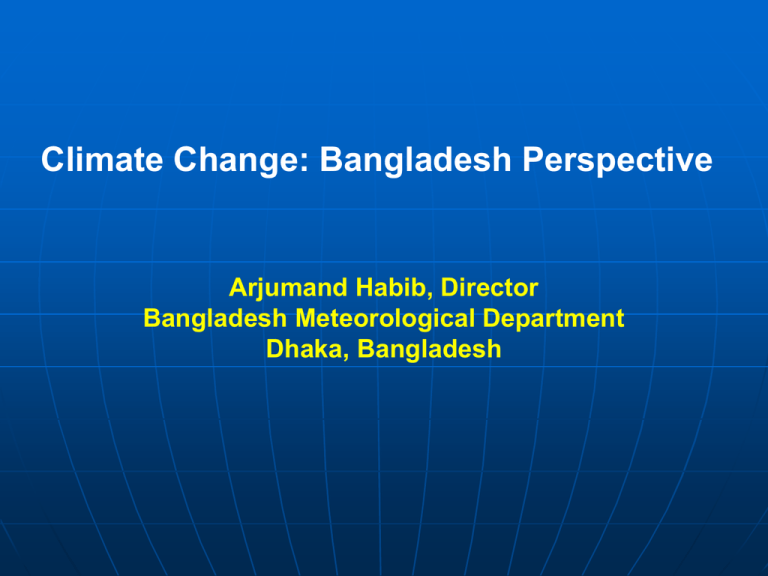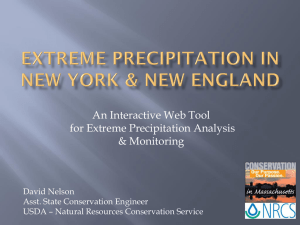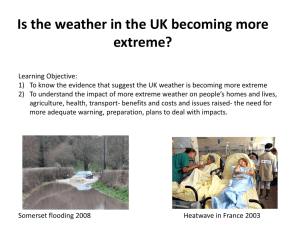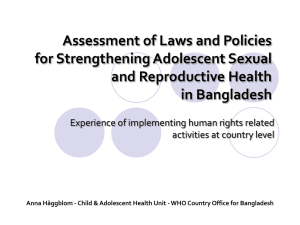Weather and Climate - Divecha Centre for Climate Change
advertisement

Climate Change: Bangladesh Perspective Arjumand Habib, Director Bangladesh Meteorological Department Dhaka, Bangladesh 1. Introduction Geographically Bangladesh is in the highly disaster prone area of deltaic origin of GangesBrahmaputra Basin having Himalayas in the north and Bay of Bengal in the south with a complex coastal configuration and shallow bathymetry. It is an agro-based tropical country, climate is southwest monsoon driven with a significant variation in rainfall and temperature over the year. Recorded tropical cyclone devastation in Bangladesh is the worst in the world. About 80% of the land is flood prone, 90% discharge of GangesBrahmaputra-Meghna basin is through Bangladesh during monsoon. Position of Bangladesh in the World Map and in the Asia Map 1. Introduction continue………. • Other than tropical cyclone, extreme events like thunderstorms, tornadoes and localized heavy rainfall causing causalities and loss which is almost close to that of one cyclone every year. • With this climate change impact would adversely affect the existing vulnerability more. • As a least developed country with highest population density (Total area of Bangladesh 143,999 square kilometers; according to the latest census report published in July 2011 population density is 964 per square kilometer; the rate of population growth is 1.34 per year and total number population increased during last 10 years is about 1.8 crore), inadequate infrastructure for protection, lack of institutional capacity for taking proper adaptation and mitigation and because of its climate sensitive economy, particularly agriculture will face enormous human suffering in terms of food, water, shelter, health and overall livelihood. • Expansion and strengthening of capacity in generation and utilization of emerging climate information and provision of effective end-to-end early warning are the urgent need to support Government, private sectors, NGO’s and public for disaster risk reduction and for adaptation and mitigation of climate change impact. 2.1 Climate of Bangladesh Bangladesh is a subtropical monsoon climate characterized by wide seasonal variations in rainfall, moderately warm temperatures, and high humidity. Based on the analysis of pressure, rainfall and temperature, the climate of this country can be described under the following four seasons: a. Winter or Northeast Monsoon: This season comprises of December, January and February; mean temperature is 18-21C and average rainfall is about 1.5% of the total annual rainfall. b. Summer or Pre-Monsoon: This season consists of March, April and May; average rain fall is 17% and mean temperature is 2330C and average rainfall is 17% . c. Southwest Monsoon or Monsoon: This season consists of June, July, August and September; average rain fall of this season is about 72.5% of the total annual rainfall. d. Autumn or Post-Monsoon: This season consists of October and November; average rainfall receives in this season is about 9%. 3. Trend of Change 3.1 Temperature: Temperature trends during last 60 years (1950-2010) based on observed data of BMD, minimum temperature and maximum temperature both have a tendency to increase, minimum more making average day temperature to follow rising trends as given in Fig. 1 and Fig. 2. 31.0 22.0 y = 0.0092x + 30.234 R2 = 0.2235 30.5 30.0 29.5 21.8 Minimum Temperature(°C) Maximum Temperature (°C) 31.5 21.6 y = 0.0107x + 20.677 R2 = 0.3359 21.4 21.2 21.0 20.8 20.6 20.4 20.2 Fig: 1: Temporal variation of annual maximum temperature of Bangladesh during 1950-2010 1950 1952 1954 1956 1958 1960 1962 1964 1966 1968 1970 1972 1974 1976 1978 1980 1982 1984 1986 1988 1990 1992 1994 1996 1998 2000 2002 2004 2006 2008 2010 20.0 1950 1952 1954 1956 1958 1960 1962 1964 1966 1968 1970 1972 1974 1976 1978 1980 1982 1984 1986 1988 1990 1992 1994 1996 1998 2000 2002 2004 2006 2008 2010 29.0 Fig: 2: Temporal variation of annual minimum temperature of Bangladesh during 1950-2010 3.2 Rainfall: Average rainfall during last 60 years (1950-2010) has a positive trend with a slight decrease in monsoon season. 3000 20 y = -0.0616x - 5.1577 2800 R2 = 0.0082 10 2600 Rainfall Deviation (%) 2200 2000 1800 1600 1400 0 -10 -20 y = 1.048x + 2224.9 R2 = 0.0043 -30 1200 -40 Fig. 3: Temporal variation of annual rainfall of Bangladesh during 19502010 1951 1953 1955 1957 1959 1961 1963 1965 1967 1969 1971 1973 1975 1977 1979 1981 1983 1985 1987 1989 1991 1993 1995 1997 1999 2001 2003 2005 2007 2009 1000 1951 1953 1955 1957 1959 1961 1963 1965 1967 1969 1971 1973 1975 1977 1979 1981 1983 1985 1987 1989 1991 1993 1995 1997 1999 2001 2003 2005 2007 2009 Rainfall (mm) 2400 Fig. 4: Inter-annual variation of monsoon rainfall in Bangladesh during 1951-2010 3. Trend of Change Continue ……….. Under a collaborative research between SAARC Meteorological Centre (SMRC) and Nagoya University on the ‘Understanding the rainfall climatology and detection of extreme weather events in SAARC region’ has done in two phases. For rainfall climatology Tropical Rainfall Measuring Mission (TRMM) data sets and for generation of extreme events RegCM (Regional Climate Model) have been used for Bangladesh and the model simulated events are compared with BMD’s observed data sets. Increasing rate of wet days is high in the NE and SE regions of Bangladesh. Regarding temperature both maximum and minimum have a rising trends, minimum more over maximum, maximum more or less stable. So both the analysis shows the signature of Global Warming. 3.3 Extreme events Tropical cyclone intensity analysis shows that since 1876 onward particularly in the last 20 years frequency and the intensity of cyclone more than 200 km/hour ha an increasing trend. Also other extreme events like heavy rainfall within short scale of time causing flash flood in pre-monsoon period are increasing and added extra pressure on monsoon flooding especially in urban area drainage congestion, prolonged water logging and landslides in the hilly region and also accelerate river erosion. Fig. 5: Intense Cyclones (wind speed >200 Km/h) over Bay of Bengal during 1876 - 2010 Fig. 6: Intense Cyclones (wind speed >200 Km/h) over Bay of Bengal during 1950 - 2010 3.3 Extreme events continue…… During 1876 – 1964 there was only one intense cyclone (wind speed more than 200 Km/h) over North Bay of Bengal but in next 45 years (1965 – 2010) it was 9. From 1950 to 1990 intense cyclones were only two but during next 20 years (1991-2010) it was 7. 3.4 Rainfall Intensity Pre-monsoon season: Frequency of heavy rainfall are increasing in March (+0.0048/year) and April (+0.0061/year) but significant increasing trend (0.0258/year) is observed in May. Therefore, heavy rainfall during monsoon season has considerable increasing trend (+0.0258/year) which means extreme weather is increasing. 12 Frequency of Heavy Rainfall 10 y = 0.0366x - 66.459 R2 = 0.0789 8 6 4 2 1950 1952 1954 1956 1958 1960 1962 1964 1966 1968 1970 1972 1974 1976 1978 1980 1982 1984 1986 1988 1990 1992 1994 1996 1998 2000 2002 2004 2006 2008 2010 0 Fig. 7: Temporal variation of Heavy Rainfall of Bangladesh in Pre-monsoon Season during 1950-2010 3.4 Rainfall Intensity continue ……… Monsoon Season: Frequency of heavy rainfall are increasing in June (+0.0006/year), July (+0.0161/year) and September (+0.0081/year) but decreasing in August (-0.0025/year). Therefore, heavy rainfall during monsoon season has also considerable increasing trend (+0.0053/year) which means extreme weather is increasing. 6.5 Frequency of Heavy Rainfall 6 5.5 y = 0.0053x - 5.5381 R2 = 0.0356 5 4.5 4 3.5 1950 1952 1954 1956 1958 1960 1962 1964 1966 1968 1970 1972 1974 1976 1978 1980 1982 1984 1986 1988 1990 1992 1994 1996 1998 2000 2002 2004 2006 2008 2010 3 Fig. 8: Temporal variation of Heavy Rainfall of Bangladesh in Monsoon Season during 1950-2010 3.5 Example of extreme events: a. Heavy Rainfall events in Dhaka on 14 August 2004 and 27 July 2009 Dhaka (city area) experienced 341 mm rainfall on 14 August 2004 and 333 mm rain on 27 July 2009 in 24 hours. Consequences of these heavy rainfalls are: • Most of the educational institutions were closed. • Life and business came to a halt. • Public transport services collapsed. • Slum dwellers lost most of their belongings. • Rain played havoc in the electricity supply creating power outage. b. Landslide on 11 June 2007 at Chittagong Heavy rainfall resulted in a landslide in Chittagong, Bangladesh on 11 June 2007, • killing 124 people and destroying houses, • roads and embankments, as well as • disrupting electricity, gas lines and • communication facilities. According to the Bangladesh Meteorological Department (BMD) rainfall measured on 11 June was 425 mm within 24 hours at Chittagong city area which is the heaviest in last 25 years. 3.6 Regional trends • It is well recognized in both the scientific and negotiating community that Bangladesh would be one of the most adversely affected countries to climate change. • According to the Fourth Assessment Report of WMO/UNEP Intergovernmental Panel on Climate Change (IPCC) released in 2007, the future projection of climate change indicates that south Asia is very likely to warm up during this century. Crop yields may decrease by 30% in the region by the mid-21st century and considering the influence of population growth, the risk of hunger is projected to remain very high. • Other predicted impacts of climate change include inundation of arable land, salinity intrusion, droughts, reduced fresh water, availability and persistence of transboundary pests and diseases. 3.7 Climate Change risks • All components of climate risk e.g. natural hazards and extreme weather events, impacts of climate change, exposure, vulnerabilities and low adaptive capacity all are visibly existent and seriously exposed because of highest density of population, their level of poverty, low adaptive capacity and natural resource dependent economyparticularly agriculture, considering all these Bangladesh will face enormous human sufferings in terms of food, water, shelter, health and overall livelihood maintenance unless proper measures are taken in time. • Expansion and strengthening of capacity in generation and utilization of the emerging climate information and provision of effective early warning is the urgent need to support the Government and people for taking proper measure for sustainable environment and socio-economic development. 3.8 Government’s Climate Change Strategy and Action Plan: Climate change strategy and action plan of Bangladesh has been drawn on the four building blocks of the Bali Action Planadaptation to climate change, mitigation, technology transfer and adequate and timely flow of funds within a framework of food, energy, water and livelihoods security for all. It is a part of overall development strategy of the country. The climate change constraints and opportunities are being integrated into the overall development strategy of the country. The climate change constraints and opportunities are being integrated into the overall plan and programme involving all sectors. The National Climate Change Action Plan is built on the following six pillars: 3.8 Government’s Climate Change Strategy and Action Plan: Continue …….. a. Food security, social protection and health to ensure that the poorest and most vulnerable in society including women and children, are protected from climate change and that all programmes focus on the needs of this group for food security, safe housing, employment and access to basic services including health. b. Comprehensive disaster management to further strengthen the countries already proven Disaster Management System to deal with increasingly frequent and severe natural calamities. c. Infrastructure to ensure that existing assets (e.g. coastal and river embankments) are well maintained and fit for purpose and that urgently needed infrastructure (e.g. cyclone shelter and urban drainage) is put in place to deal with likely impacts of climate change. 3.8 Government’s Climate Change Strategy and Action Plan: Continue …….. d. Research and knowledge management to predict the likely scale and timing of climate change impacts on different sectors of the economy and socio-economic groups to underpin future investment strategies; and to ensure that Bangladesh is a network into the latest global thinking on science and best practices of climate change management. e. Mitigation and low carbon development to evolve low carbon development options and implement these as the country’s economy grows over the coming decades and the demand for energy increases. f. Capacity building and institutional strengthening to enhance the capacity of Government ministries and agencies, civil society and the private sector to meet the challenge of climate change and mainstream them as a part of development action. 4. Measures taken for proper applications of weather and climate in disaster risk reduction and adaptation and mitigation of climate change: Weather and climate information and an effective early warning system are the key elements for addressing climate change and reducing natural disaster risk. 4.1 Mandate of BMD BMD is mandated to observe and monitor the weather and climate systems and issue of forecasts and warnings for all sorts of operations pertaining to Aviation, Maritime, Inland Water Ways and advisories to the Disaster Management Bureau (DMB) and Relief Ministry in managing all types of natural disasters and its application in social and economic planning. 4. 2 Efforts for Disaster Risk Reduction For disaster risk reduction the following are the four operation components for a successful of an end-to-end early warning system: • Generation of reliable and timely warnings • Quick and reliable dissemination to the targeted people and area • Good governance and all types of physical protections • People’s sufficient awareness and perception about the content of the warning message and their resilient to sustain disaster. Fig. 9: Variation of GDP growth rate of Bangladesh under the influence of natural disasters. Efforts for Disaster Risk Reduction continue………… To execute the above perspectives, in the operation of an end-to-end early warning system the Government has made paradigm shift in policy and governance by shifting from the concept of relief and rehabilitation to overall disaster risk management. Bangladesh has a long history of coping with major disasters. The Government of Bangladesh and people have a wealth of experience in preparing for, and responding to disaster events. In recent years, Bangladesh has been increasingly recognized as a leader in adopting a more holistic approach to risk reduction. Efforts for Disaster Risk Reduction continue………… 200000 During the last 38 years BMD has made significant improvement in cyclone forecasting and warnings as well as in the timely prediction of other severe weather phenomena, thereby contributing directly to the reduction of losses. The gradual reduction of death tolls for tropical cyclone is shown in figure below: 202500 195000 187500 180000 172500 165000 200000 200000 138882 157500 150000 142500 135000 127500 120000 138882 150000 112500 105000 97500 90000 82500 75000 100000 50000 3363 Cy_2007 Cy_2007 2 Cy_2002 Fig. 10: Causalities along with recorded cyclones in Bangladesh during 1970-2009 Cy_1991 3 Cy_2000 190 14 Cy_1998 Cy_2009 78 155 Cy_1997 188 Cy_1994 Cy_1991 Cy_1997 6133 Cy_1988 4264 Cy_1985 43 300 Cy_1983 Cy_1983 Cy_1981 Cy_1974 Cy_1970 20 22500 15000 7500 0 72 0 3363 Cy_1970 67500 60000 52500 45000 37500 30000 Fig. 11: Trend of reduction of causalities during similar intensity cyclones in Bangladesh 4.3 Government initiatives for the Meteorological Service in Bangladesh improvement of • To contain the climate change impact, natural disaster risks and keeping environment for sustainable economic development, overall capacity enhancement of Bangladesh Meteorological Department (BMD) in the provision of effective early warning system for extreme events and proper climate services is extremely important. • In the face of increasing extreme events and the vulnerability of climate change, demands for such accurate forecasts/warnings, more precise application of climate data and information based on local climate scenario development are increasing. • Also, to maintain the food security and sustainable socio-economic development, capacity for seasonal climate forecast for agriculture and climate scenario development in local perspective for proper adaptation and mitigation of climate change impact are very important for BMD. For overall capacity enhancement of BMD in forecasting along with institutional up-gradation, the following initiatives are taken: Institutional up-gradation: Quality performance is the most important component for delivery of quality service. In terms of technological development, may initiatives have been undertaken at the moment to develop the infrastructural facilities and human capacity in BMD. But to uphold the efforts of sustainable development in the meteorological service, it is imperative that quality human resources be integrated with the system. For upholding BMD’s mandate in new perspective of climate change and disaster risk reduction efforts of Government, a proposal has been submitted to the Government for induction of quality manpower along with institutional expansion for operation and maintenance of Numerical Weather Prediction (NWP), climate modeling, seasonal forecasting and more accurate and timely early warning system. Infrastructural development BMD has taken many initiatives to modernize the existing weather and climate observatories, establishing new observatories, introduction of sophisticated Radar and Communication Systems, capacity building for Numerical Weather Prediction (NWP) System, downscaling capacity for climate modeling and up-gradation of storm-surge modeling system. As such the following projects have been taken during the last three years: a. ‘Improvement of Meteorological Radar System at Cox’s Bazar and Khepupara’ b. ‘Establishment of Meteorological Radar System at Moulvibazar’ c. ‘Establishment of 1st Class Observatory at Five Places of Bangladesh” Infrastructural development Continue ……. • ‘Up-gradation of Agro-meteorologiacl Services’ • ‘Development of Human Capacity on Operation of Weather Analysis & Forecasting’ • ‘Preparation of Wind Map of Coastal Areas/Feasible Areas of Bangladesh for Assessing Power Generation Potential’ • ‘Improvement & Relocation of Dhaka Meteorological Radar System for operation in aviation and Riverine Sectors and Protection of Urban System against National Disasters’ • ‘Numerical Weather Prediction System (2nd Phase)’ • ‘Up-gradation of 35 surface observatories through Establishment of Automatic Meteorological Observing System & Wind Profilers’ • ‘Collaborating with International Centre for Theoretical Physics (ICTP), Italy, Beijing Climate Centre (BCC), China and South Asian Climate Outlook Forum (SASCOF) Infrastructural development Continue ……. k. Training programme on Storm Surge Modeling with expertise support from Japan Meteorological Agency (JMA) and sponsored financially by Regional Integrated Multi-hazard Early Warning System (RIMES) has been arranged and in future we have a plan with WMO through Coastal Inundation Forecasting Demonstration Project (CIFDP) in Bangladesh to integrate Storm Surge Model with Inundation Model to give local Specific surge height and inundation for taking better preparedness and local level. l. Global Framework for Climate Services (GFCS) is particularly meant for facilitation the Governments in taking proper adaptation for the introduction of an end-to-end multi-sectoral service delivery system based on climate prediction utilizing national, regional and internationally collected weather and climate data. Furthermore, for effective utilization of GFCS opportunities, association with Regional Climate Centres (RCC’s) and Regional Climate Outlook Forum (RCOF) are important in achieving the national capacity to downscale and integrate those into the prediction system. 5. Conclusion • BMD is at present in a phase of transition; it is modernizing its observation and communication networks, changing the forecasting system from subjective to objective method and training its personnel to adapt to the ongoing change. • But in the context of climate change BMD needs capacity enhancement urgently in the field of proper data management, downscaling capacity with data assimilation for global NWP products and climate model, tools of interaction to meet sectoral demands and strengthening the existing linkage with main stakeholders and users. • Furthermore, for effective utilization of GFCS opportunities, association with Regional Climate Centres (RCC’s) and Regional Climate Outlook Forum (RCOF) are important, prior to achieve the national capacity to downscale and integrate those into prediction system. 5. Conclusion continue………. • Bangladesh by virtue of its being an agro-based country, would be immensely benefited by accurate and reliable seasonal and multiple year long range prediction to guide farmers on the best cropping strategies and securities. • The recent increase of Government association in the number of international agreements, declarations, conventions, related to weather, climate, water and related environmental issues requires more involvement of meteorological service. • To make all the efforts fruitful, more international support and regional co-operation are required in terms of technology transfer, infrastructure development, capacity building and real time exchange of data and information which are quite indispensible for BMD. Thanks








